Introduction to the Nervous System:
The nervous system is one of the most complex systems in animals, especially human. The central nervous system contains over 100 billion neurons, and it is estimated to be about 1010 -1011 in human. The most intricate system in the human body is the nervous system. It consists of:
- Nerve cells (neurons)
- Glial cells
- Nerve fibers
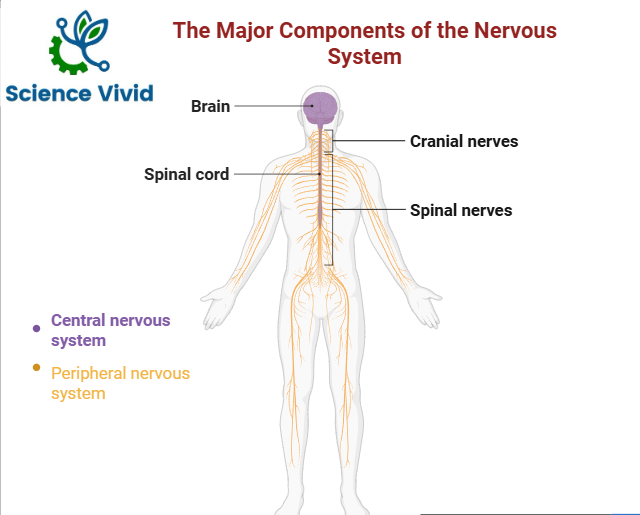
Fig: The Major Components of the Nervous System
Nerve tissue is distributed throughout the body as an integrated communications network. A network of almost 100 billion neurons facilitates communication. On average, each neuron contains at least a thousand connections to neighboring neurons, creating an extremely intricate communication system. Neurons are responsible for reception, transmission, and processing of stimuli.
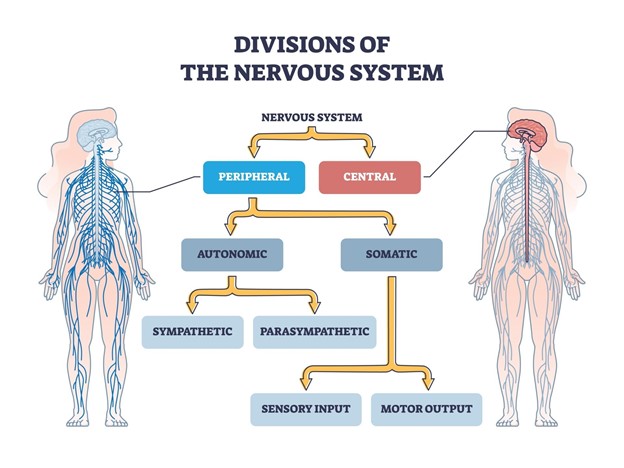
Fig: Division of Nervous system
Structure and Anatomy of a Neuron:
Neurons, also referred to as neurones or nerve cells, are the basic building blocks of the brain and nervous system. They are the cells that receive sensory information from the outside world, send motor commands to our muscles, and transform and relay electrical signals at each stage in between.
A neuron is made up of three primary elements, which can be compared to the branches, roots, and trunk of a tree: dendrites, axons, and the cell body, or soma.
Types of neurons:
According to the shape and size of their processes
- Multipolar neurons have more than 2 cell processes (one process being the axon and the others dendrites.
- Bipolar neurons have one dendrite and one axon.
- Near the cell body, pseudounipolar neurons have a single process that splits into two branches.
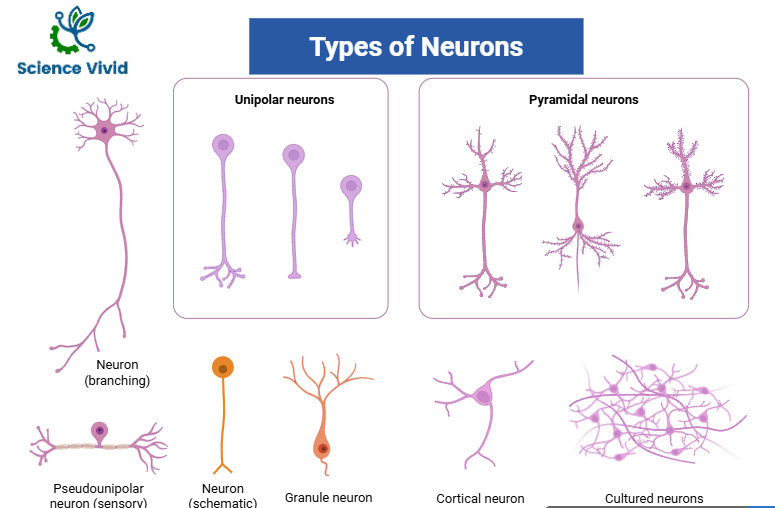
Fig: Types of neurons
Types of neurons according to their functions:
- Motor (efferent) neurons control effector organs such as muscle fibers and exocrine and endocrine glands.
- Sensory (afferent) neurons are involved in the reception of sensory stimuli from the environment and from within the body.
- Interneurons establish relationships among other neurons forming complex functional networks.
The main character features of the nerve cells
- A big nucleus with a prominent nucleolus is present in the majority of nerve cells.
- A granular substance known as the Nissl substances (Nissl body) is present in the cytoplasm of the nerve cell and exhibits strong staining with basic dyes.
- An axon hillock is a portion of the neuron body that is devoid of the Nissl body, from which the axon grew.
- The portion of the axon between the axon hillock and the point at which myelination begins is called the initial segment.
- Some axons are surrounded by a myelin sheath. Axon having a myelin sheath are called myelinated axons.
- There are some axons that are devoid of myelin sheath. These are unmyelinated axons. Axons constitute what are commonly called nerve fibers
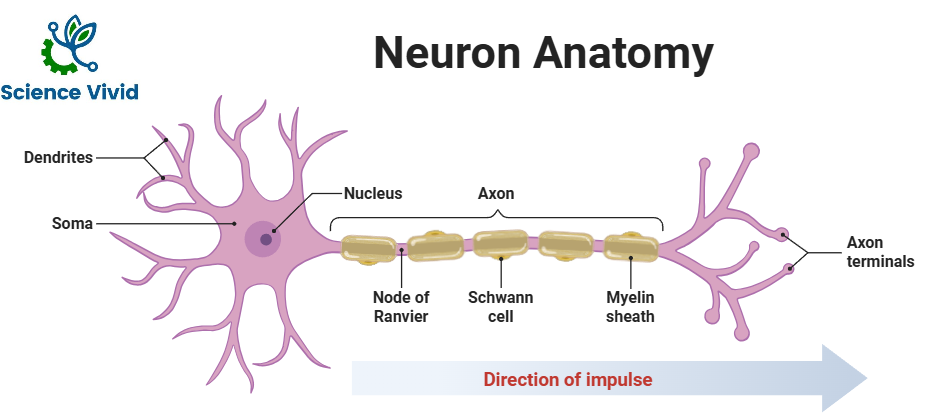
Fig: Structure and anatomy of neuron
Glial Cells (neuroglia) of the Nervous System:
In nervous system, glial cells serve both protective and supportive purposes.
The neuroglia includes:
Astrocytes
The most prevalent kind of glial cells are called astrocytes. They have role in supporting and controlling ionic and chemical environment of neurons.
Oligodendrocytes
Oligodendrocytes produce the myelin sheath for axon in the central nervous system.
Schwann cells
The peripheral nervous system’s myelin coating is made by Schwann cells.
Ependymal cells
Ependymal cells are found in the central nervous system which facilitate the movement of cerebral spinal fluids.
Microglia
Microglia have phagocytic function.
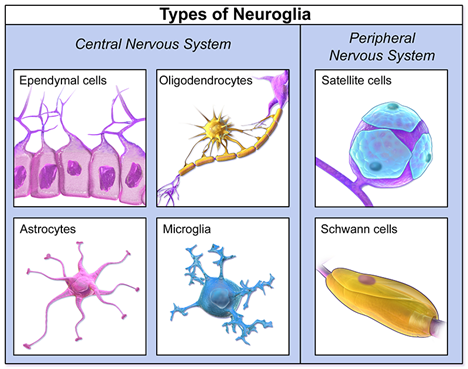
Fig: Glial cells of Nervous system
Structure of a nerve:
An external collection of neuronal fibers forms what is known as a nerve.
Endoneurium
Every single nerve fiber is surrounded by a fine, protective covering of connective tissue termed the endoneurium.
Perineurium
Several fibers are bundled together into fascicles, held in place by a thicker connective tissue layer called the perineurium.
Epineurium
To create the cord-like nerve, all of the fascicles are ultimately joined by a strong, fibrous sheath known as the epineurium.
Types of Nerves:
Sensory nerves
Also known as afferent nerves, sensory nerves are the sole nerves that send signals to the central nervous system.
Motor nerves (Efferent nerves)
These nerves carry only motor signals, transmitting instructions from the central nervous system to muscles or glands.
Mixed nerves
These contain a combination of sensory and motor fibers, allowing them to both relay sensations to the central nervous system and send out motor commands.
Functions of the nervous system:
Sensory function
Information is gathered by the nervous system from both inside and outside the body.
Integration function
Nervous system transmits information to the processing areas of the brain and spine and processes the information in the brain and spine.
Motor function
Nervous system sends information to the muscles, glands, and organs so they can respond appropriately.
Central Nervous System (CNS):
The central nervous system (CNS) consists of
Brain
About 85 billion neurons make up the brain, which is the portion of the central nervous system that is housed in the skull.
Spinal cord
The vertebral column’s bones enclose the spinal cord, which is joined to the brain via the occipital bone’s foramen magnum. The spinal cord contains about 100 million neurons.
Peripheral Nervous System (PNS):
The peripheral nervous system consists of
Sensory (afferent) division
It comprises of the nerve fibers that carry information to the central nervous system
Motor (efferent) division
Somatic Nervous System (SNS)
Autonomic Nervous System (ANS)
- Sympathetic Division
- Parasympathetic Division
- It comprises of the nerve fibers that carry impulses away from the central nervous system.
- The somatic and autonomic nervous systems are further separated into the motor division.
Only skeletal muscles receive output from the central nervous system (CNS) through the somatic nervous system (SNS). The action of this PNS region is voluntary since its motor responses are consciously controllable.
The CNS sends output to smooth muscle, cardiac muscle, and glands through the Autonomic Nervous System (ANS). The ANS’s action is involuntary since its motor responses are typically not controlled by conscious thought. The parasympathetic nervous system and the sympathetic nervous system are the two primary branches that make up the ANS. - Sympathetic & parasympathetic divisions typically function in opposition to each other.
- Sympathetic nervous system acts as accelerator and parasympathetic as brake.
- Sympathetic nervous system imparts quick responses “fight or flight”
- Parasympathetic functions with actions that do not require immediate reaction “rest and digest”
